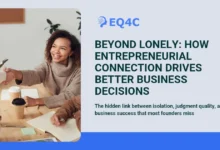Is Your Seed Stage Pitch Falling Flat? Uncover the Secrets to Winning Over Investors!
Learn how to craft a compelling seed stage startup pitch, avoid common mistakes, and secure funding with our proven investor tips, traction strategies, and unique insight techniques.

Key Takeaways for a Successful Seed Stage Pitch
Before we dive deep, let’s highlight the three most important things you should remember when pitching your seed-stage startup:
- Clarity is King: Investors need to understand what you do quickly and easily. Don’t get lost in jargon or fancy language.
- Traction Talks: Even pre-launch, showing what you’ve accomplished (even small wins) demonstrates your ability to execute.
- Conversation, Not Presentation: Engage investors in a dialogue. Let them talk, ask questions and convince themselves about your vision.
Let’s set the TONE
Pitching to investors is, let’s face it, one of the most painful things we do as founders.
I’ve been there, and I know how much it stings when investors say no. It’s easy to let that “no” fuel a desire to prove them wrong. But here’s the deal: the goal today isn’t to talk about revenge.
It’s to give you solid tips on how to be more successful when you’re fundraising at the seed stage – specifically when you’re pre-product market fit.
This advice isn’t for those raising Series A rounds. Instead, I want to help us all unlearn some of the bad fundraising advice floating around so we can focus on what actually works.
Key Principles
When it comes to pitching, a few key principles can really make a difference.
First and foremost, I’ve found that you must stand out by being concise and easy to understand. I know it’s tempting to bring a lot of energy and “shark tankiness” into the room, but that’s often a mistake.
Instead, focus on clarity and simplicity. Avoid overly complicated language. The crucial thing here is that investors understand what your company does.
The number one reason for an investor not knowing what your company does? It’s often us, the founders.
Common Elements of a Pitch
Okay, now let’s get to the core of it. There are some crucial components you absolutely need to be able to talk about during your pitch. These are:
- What your company does.
- Who is on your team.
- What your traction is.
- What are your unique insights?
- What your market size is.
- What you are asking for.
I promise, if you get these elements down, you’ll be in a much better position.
What Do You Do?
This is where we really need to be clear. Explain what your company does in just two sentences, I mean it! Then, give a specific example.
This example, I think, is where the magic happens. Your example should be so clear it sticks in their memory. Make sure your example illustrates both the problem your company is solving and the solution.
- Problem: Inherent in your example should be the problem that you’re trying to fix.
- Solution: The solution should be very clear in the example.
Let me address some common mistakes I’ve seen myself:
- Explaining like a customer: Often, I’ve seen founders explain things in a way a customer would understand but an investor would not. Investors aren’t your users. They don’t have the same background or jargon as your customers. You have to use language they’ll understand.
- Two Answers: You absolutely need to have two different answers to “What do you do?”: one for your customers and another for investors. The words on your website are for customers, not investors.
- Accuracy vs. Clarity: It is tempting to strive for 100% accuracy, but it’s more important to be clear. Aim for 80% accurate and 100% clear.
- Vague examples: A vague or general example will not stick. Use specific examples, every time.
- Missing problem/solution: Do not forget to illustrate both the problem and the solution in your example.
- First Slide Faux Pas: Do not make the mistake of having just your logo on the first slide. Investors should know what you do from the first slide. Do not leave them guessing. Ask them if they understand or if another example would be helpful to them.
Your Team
The purpose of the “team” part of your pitch is clear: introduce who is working with you.
Talk about what they do, highlight their impressive accomplishments and credentials, and – if possible – show how they’ve personally experienced the problem you’re solving.
Personal experience helps position you as an expert.
But here’s where I think some common mistakes happen:
- Missing Titles and Roles: Always include titles and roles. Investors want to know who the CEO is and who is writing the code.
- Life Stories: Avoid the temptation to tell long stories. Unless they ask you, do not feel the need to give your life story.
- Missing specific accomplishments: If you’ve done something cool, say it! Just leave out the life story.
Traction
Traction is simply a clear explanation of what you have accomplished since you started working on your company.
This part is about showing progress. Remember: only use a graph if it is “up and to the right.” Traction communicates what you’ve done and why it is impressive.
I want to emphasize that you can have traction even if you are pre-launch or you don’t have a killer graph.
For instance, building an iOS app in test flight with 100 users within a month is good traction. Investors want to see momentum and the ability to get things done quickly. It’s important that you include how much time you’ve spent to achieve what you’ve done.
Let’s be honest, there are some mistakes people make with traction slides:
- Missing Time: Always, include how much time it took you to achieve that traction.
- Fake Work: Including “fake work” does not help your company or impress investors.
- Bad Slide vs. No Slide: A bad traction slide is worse than no traction slide at all. If it is week two of your startup, do not expect to have any impressive traction.
Unique Insights
This is where you show what you’ve learned that others might not know. Unique insights are the non-obvious things you have learned about the problem, the customer or the solution.
However, keep in mind that you only have the right to talk about unique insights if investors understand what your company does and are impressed with your team. Think about the Airbnb example where the unique insight was that by processing payments themselves, they could create much needed trust.
Avoid these mistakes when talking about your insights:
- Not Unique: The insight is not unique if most people would agree with it. If it is obvious, it is not unique.
- Not Specific: When giving examples, be specific. Use a story of how you learned that insight to make the story stick.
- Lacking Support: Use numbers and facts to back up your insights.
Market Size
Here’s an important truth:
**how you calculate the market size is more important than the number itself.
* You need to teach investors about your potential users, how you price your product, and why* you charge that amount.
Show a “bottoms up” calculation of how many users you’ll have and how much they will spend.
You might make these errors:
- Quoting without explaining: Do not quote reports without breaking down the details of those reports.
- No Math: It is important that you show the math of your calculation. Investors need to know how you got to your numbers.
- Missing Comparisons: Do not forget to talk about comparable products and their pricing.
The Ask
Here’s where it gets real:
you must actually ask for money. I have seen way too many pitches end without the founder making the ask. Investors tend to fall into three categories when they’re listening to a pitch. They are thinking:
- “I will never fund this company” (most common)
- “I will definitely fund this company” (least common)
- “If they ask me, it will be uncomfortable for me to say no” (can be up to 10% of the time).
You must ask to tap into that last category. It’s crucial.
Here are common mistakes I have seen:
- Not Asking: Simply put, do not forget to ask for money.
- Missing Social Proof: Include the social proof that you already have, such as who has already invested.
- Hiring vs. Action: Talk about what you will do with the money rather than who you will hire.
- Empty Goals: Your “ask” slide should focus on revenue or usage milestones. Include a goal of where you want to be in 18-24 months. Make it a goal that would excite investors.
Overall Pitch Strategy
This is how to put all this together. I think you should order your points from most impressive to least impressive.
“What do you do” should be first, and the “ask” should be last. The order of the remaining parts depends on what you think is most impressive.
Do not feel stuck in a set format, you can change the order to make your most important points first.
Keep in mind you earn every two minutes of the meeting, especially on Zoom.
Do not leave the good stuff to the end. Treat your pitch like a conversation, not a book report. The goal is not for you to deliver something, but to draw them into a conversation. Investors convince themselves the more they talk. You want to aim for the investor to talk 50% or more of the time.
If an investor shows interest, run with it and get them talking, do not stick to the order of your slides. Jump to where they are most interested. Also, Pay attention to the investor; you can tell if they are interested by looking at their face.
Finally, do not use distracting slides. Use basic, boring slides, so investors focus on you and what you are saying. If a designer builds the slides, they may emphasize the wrong things. Keep slides clear and concise, not sexy and sizzle.
Example Pitch (YC)
Here’s a simple example, using Y Combinator as an example:
| Slide Section | Details |
|---|---|
| What We Do | Startup accelerator that funds early-stage startups. $500,000 standard deal. |
| Example | Experience of being funded by YC. |
| Traction | YC has funded many companies with over $100 million in revenue. |
| Team | YC partners have experience as startup founders, investors, etc. |
| Unique Insights | Application access leads to better deal flow. Funding in a batch creates a support system. Demo day creates a fundraising auction. |
| Market Size | Tech IPOs generate about $10 billion per year. |
| The Ask | Apply. |
Final Thoughts
Pitching for seed funding is a challenge. It’s not about having a perfect presentation or reciting a script. It is about connecting with investors, making them understand what you are building and why it matters. Focus on being clear, showing your progress, and engaging in a real conversation. You can do this! Remember to follow these tips and practice often to make your pitch the best it can be.
Thank you for taking the time to read my thoughts on seed-stage pitching. I hope these tips will help you achieve your fundraising goals. Keep visiting eq4c.com for more helpful content!




